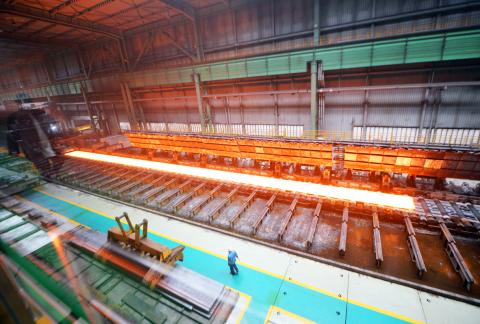Baoshan Iron & Steel Co (Baosteel, 寶鋼) started production at its new project in China’s southern port city of Zhanjiang even as steel prices plunge amid sluggish demand in the country, which is facing its slowest pace of economic growth in 25 years.
The No. 1 blast furnace of the project, designed to have an annual capacity of 4.1 million tonnes of melted iron, was ignited on Friday, China’s biggest publicly traded steelmaker said in a filing to the Shanghai Stock Exchange yesterday.
The project will be fully operational a year later with an expected annual crude steel production of 8.75 million tonnes, Baosteel said.

Photo: AFP
It usually takes three to six months of trial production before a new steel mill begins commercial operation.
Chinese mills face declining domestic demand for the first time in a generation amid a property slump, which crushed prices in the nation that produces more than half of world output.
Steel reinforced bar, which is used in construction, almost halved in the past two years on the Shanghai Futures Exchange while hot-rolled coil, used in automobile and machinery, dropped 42 percent since its debut in March last year.
Baosteel last month said that it expected a 50 percent to 60 percent drop in net income for the first nine months of the year, citing foreign exchange losses related to debt restructuring after a surprise yuan devaluation.
Chinese steel demand has plateaued at about 800 million tonnes, Nev Power, chief executive officer of Fortescue Metals Group Ltd said in an interview on Tuesday. Any rise beyond that will probably be driven by stimulus, infrastructure and property development growth, he said.
However, Vale SA pushed back against claims steel consumption in China has peaked, saying demand in the top user still has some way to go in a view that contrasts with a rising number of global banks.
“China’s steel consumption peak is still ahead of us but of course the growth will be much more gradual,” Vale global director of ferrous marketing and sales Claudio Alves said.
Vale aimed to boost its market share, he said.
Major global miners are seeking to figure out the implications of slowing growth in China on demand for everything from iron to copper.
While Vale’s view echoes outlooks from Rio Tinto Group and BHP Billiton Ltd, Australia & New Zealand Banking Group Ltd brought forward its peak-steel estimate to last year from 2020 and Credit Suisse Group AG said local consumption will shrink 10 percent by 2018.
“Despite the slowdown of the growth speed, China still remains the economic engine of the world,” Alves said.
Further urbanization and infrastructure projects will underpin demand for iron ore, steel, copper and other base metals, he said.

WEAKER ACTIVITY: The sharpest deterioration was seen in the electronics and optical components sector, with the production index falling 13.2 points to 44.5 Taiwan’s manufacturing sector last month contracted for a second consecutive month, with the purchasing managers’ index (PMI) slipping to 48, reflecting ongoing caution over trade uncertainties, the Chung-Hua Institution for Economic Research (CIER, 中華經濟研究院) said yesterday. The decline reflects growing caution among companies amid uncertainty surrounding US tariffs, semiconductor duties and automotive import levies, and it is also likely linked to fading front-loading activity, CIER president Lien Hsien-ming (連賢明) said. “Some clients have started shifting orders to Southeast Asian countries where tariff regimes are already clear,” Lien told a news conference. Firms across the supply chain are also lowering stock levels to mitigate

IN THE AIR: While most companies said they were committed to North American operations, some added that production and costs would depend on the outcome of a US trade probe Leading local contract electronics makers Wistron Corp (緯創), Quanta Computer Inc (廣達), Inventec Corp (英業達) and Compal Electronics Inc (仁寶) are to maintain their North American expansion plans, despite Washington’s 20 percent tariff on Taiwanese goods. Wistron said it has long maintained a presence in the US, while distributing production across Taiwan, North America, Southeast Asia and Europe. The company is in talks with customers to align capacity with their site preferences, a company official told the Taipei Times by telephone on Friday. The company is still in talks with clients over who would bear the tariff costs, with the outcome pending further

Six Taiwanese companies, including contract chipmaker Taiwan Semiconductor Manufacturing Co (TSMC, 台積電), made the 2025 Fortune Global 500 list of the world’s largest firms by revenue. In a report published by New York-based Fortune magazine on Tuesday, Hon Hai Precision Industry Co (鴻海精密), also known as Foxconn Technology Group (富士康科技集團), ranked highest among Taiwanese firms, placing 28th with revenue of US$213.69 billion. Up 60 spots from last year, TSMC rose to No. 126 with US$90.16 billion in revenue, followed by Quanta Computer Inc (廣達) at 348th, Pegatron Corp (和碩) at 461st, CPC Corp, Taiwan (台灣中油) at 494th and Wistron Corp (緯創) at

NEGOTIATIONS: Semiconductors play an outsized role in Taiwan’s industrial and economic development and are a major driver of the Taiwan-US trade imbalance With US President Donald Trump threatening to impose tariffs on semiconductors, Taiwan is expected to face a significant challenge, as information and communications technology (ICT) products account for more than 70 percent of its exports to the US, Chung-Hua Institution for Economic Research (CIER, 中華經濟研究院) president Lien Hsien-ming (連賢明) said on Friday. Compared with other countries, semiconductors play a disproportionately large role in Taiwan’s industrial and economic development, Lien said. As the sixth-largest contributor to the US trade deficit, Taiwan recorded a US$73.9 billion trade surplus with the US last year — up from US$47.8 billion in 2023 — driven by strong